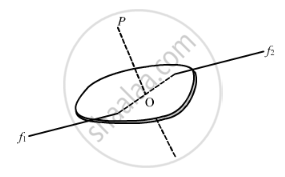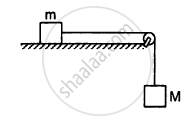Advertisements
Advertisements
प्रश्न
Particles of masses 1 g, 2 g, 3 g, .........., 100 g are kept at the marks 1 cm, 2 cm, 3 cm, ..........., 100 cm respectively on a metre scale. Find the moment of inertia of the system of particles about a perpendicular bisector of the metre scale.
उत्तर
It is given that the perpendicular bisector of the metre scale is passed through the 50thparticle.
Therefore, on the L.H.S. of the axis, there will be 49 particles and on the R.H.S., there will be 50 particles.
Consider the two particles positioned at 49 cm and 51 cm.
Moment of inertia due to these two particles = 49 × (1)2 + 51 × (1)2
I1 = 100 × 1 = 100 gm-cm2
Similarly, if we consider particles positioned at 48 cm and 52 cm, we get
I2 = 100 × (2)2 gm-cm2
Thus, we will get 49 such sets and one particle at 100 cm. Therefore, total moment of inertia,
\[I = \left( I_1 + I_2 + I_3 . . . . . + I_{49} \right) + I'\]
Here, I' is the moment of inertia of particle at 100 cm.
\[So, I = 100 \left( 1^2 + 2^2 + 3^2 + . . . + {49}^2 \right) + 100 \left( 50 \right)^2 \]
\[ = 100 \left( 1^2 + 2^2 + 3^2 + . . . + {50}^2 \right)\]
\[ = 100 \times \frac{\left( 50 \times 51 \times 101 \right)}{6}\]
\[ = 100 \times 25 \times 17 \times 101 = 4292599 gm - {cm}^2 \]
Or, I = 0.429 kg-m2 ≃ 0.43 kg-m2

APPEARS IN
संबंधित प्रश्न
A closed cylindrical tube containing some water (not filling the entire tube) lies in a horizontal plane. If the tube is rotated about a perpendicular bisector, the moment of inertia of water about the axis __________ .
A cubical block of mass M and edge a slides down a rough inclined plane of inclination θ with a uniform velocity. The torque of the normal force on the block about its centre has a magnitude
The centre of a wheel rolling on a plane surface moves with a speed \[\nu_0\] A particle on the rim of the wheel at the same level as the centre will be moving at speed ___________ .
A solid sphere, a hollow sphere and a disc, all having same mass and radius, are placed at the top of a smooth incline and released. Least time will be taken in reaching the bottom by _________ .
A solid sphere, a hollow sphere and a disc, all having same mass and radius, are placed at the top on an incline and released. The friction coefficients between the objects and the incline are same and not sufficient to allow pure rolling. Least time will be taken in reaching the bottom by ___________ .
In the previous question, the smallest kinetic energy at
the bottom of the incline will be achieved by ___________ .
A string of negligible thickness is wrapped several times around a cylinder kept on a rough horizontal surface. A man standing at a distance l from the cylinder holds one end of the string and pulls the cylinder towards him (see the following figure). There is no slipping anywhere. The length of the string passed through the hand of the man while the cylinder reaches his hands is _________ .
Three particles, each of mass 200 g, are kept at the corners of an equilateral triangle of side 10 cm. Find the moment of inertial of the system about an axis joining two of the particles.

Three particles, each of mass 200 g, are kept at the corners of an equilateral triangle of side 10 cm. Find the moment of inertial of the system about an axis passing through one of the particles and perpendicular to the plane of the particles.

Find the moment of inertia of a pair of spheres, each having a mass mass m and radius r, kept in contact about the tangent passing through the point of contact.
The surface density (mass/area) of a circular disc of radius a depends on the distance from the centre as [rholeft( r right) = A + Br.] Find its moment of inertia about the line perpendicular to the plane of the disc thorough its centre.
Because of the friction between the water in oceans with the earth's surface the rotational kinetic energy of the earth is continuously decreasing. If the earth's angular speed decreases by 0⋅0016 rad/day in 100 years find the average torque of the friction on the earth. Radius of the earth is 6400 km and its mass is 6⋅0 × 1024 kg.
The following figure shows two blocks of mass m and M connected by a string passing over a pulley. The horizontal table over which the mass m slides is smooth. The pulley has a radius r and moment of inertia I about its axis and it can freely rotate about this axis. Find the acceleration of the mass M assuming that the string does not slip on the pulley.

A metre stick weighing 240 g is pivoted at its upper end in such a way that it can freely rotate in a vertical place through this end (see the following figure). A particle of mass 100 g is attached to the upper end of the stick through a light string of length 1 m. Initially, the rod is kept vertical and the string horizontal when the system is released from rest. The particle collides with the lower end of the stick and sticks there. Find the maximum angle through which the stick will rise.

A sphere of mass m rolls on a plane surface. Find its kinetic energy at an instant when its centre moves with speed \[\nu.\]
